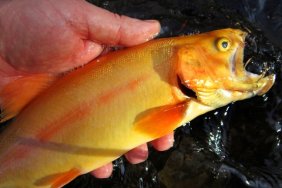 A while back, a former coworker of mine took a trip to Florida to relax and do some inshore fishing. When he returned, he brought back great stories and a lot of photos of the fish he caught. Several of the pictures depicted him holding up a fish he had never previously caught, but always wanted to. The fish were big, bore ornate patterns on their scales, and some even had large bony lumps above their heads. Those of you in the know may already have a notion of to what fish I’m referring: the peacock bass.
A while back, a former coworker of mine took a trip to Florida to relax and do some inshore fishing. When he returned, he brought back great stories and a lot of photos of the fish he caught. Several of the pictures depicted him holding up a fish he had never previously caught, but always wanted to. The fish were big, bore ornate patterns on their scales, and some even had large bony lumps above their heads. Those of you in the know may already have a notion of to what fish I’m referring: the peacock bass.
As far as appearance is concerned, the peacock bass is one of the most unique fish you’ll ever find. With a body shape similar to bass, the fish are a vibrant shade of green and have broad, dark vertical stripes on their sides. On top of all that, they also possess a tail spot that resembles the one found on peacocks, which is where the fish gets its name. Adult males also bear a pronounced hump on their foreheads.
Found predominantly in South America, along the Amazon River basin, peacock bass have also spread north through Central America, and can now be found in Florida, and as far east as Hawaii. They were introduced to Florida in the mid 1980’s as part of an effort to eradicate nuisance non-native species, like oscars. Since then, the species has flourished and has become one of the most popular sport species in the area.
Due to their territorial and aggressive nature, peacock bass are notorious for aggressively striking topwater lures. Good choices when peacock bass are active are stick lures, like Heddon’s Zara Spook, or propeller lures, like Luhr Jensen’s Woodchopper. Color choice doesn’t matter as much as you may think, since peacock bass will strike almost anything when they’re active. If you want to try subsurface lures for peacock bass, you have a few options to choose from, as well. Jerk baits and minnow baits work well around structure and open water alike. When faced with opportunities like river bends and sharp points, crankbaits will yield good numbers. The lure that my former coworker claimed to work very well—better than the other subsurface lures he tried, in fact—was a darter-style, bucktail jig jerked rapidly through the water. He threw a 1-oz jig and ripped it through the water without letting it get too close to the bottom, which allowed the bucktail to pulse with each pause. This tactic helped him pull in a lot of fish, and he had the photos to prove it.
If you’re the type of angler who likes a good fight and aggressive strikes, then peacock bass are just the fish for you seek out next. They’ve become so popular among sport fishermen throughout the years, and it’s no secret why. The peacock bass strikes like a tarpon, fights like a big smallmouth, and looks so beautiful when you see it up close. If you find yourself heading to Florida—or better yet, the Amazon—take the time to locate a good spot to find peacock bass and prepare for the time of your life!








